Related Research Articles
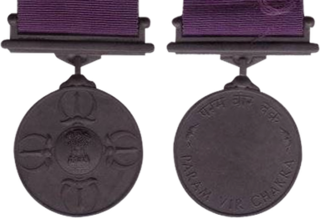
The Param Vir Chakra (PVC) is India's highest military decoration, awarded for displaying distinguished acts of valour during wartime. Param Vir Chakra translates as the "Greatest of the Ultimate Brave", and the award is granted for "most conspicuous bravery in the presence of the enemy".The medal of the PVC was designed by Savitri Khanolkar wife of Vikram Ramji Khanolkar a Maratha royal of Sawantwadi State he was also an Indian army officer who was posthumously promoted to the rank of Major General.Their daughter's brother-in-law, Major Somnath Sharma, was coincidentally awarded the first PVC. As of January 2018, the medal has been awarded 21 times, of which 14 were posthumous and 16 arose from actions in Indo-Pakistani conflicts. Of the 21 awardees, 20 have been from the Indian Army, and one has been from the Indian Air Force. A number of central and state governments and ministries of India provide allowances and rewards to recipients of the PVC. Only 21 military personnel have received this award to date.

The Maha Vir Chakra (MVC) is the second highest military decoration in India, after the Param Vir Chakra, and is awarded for acts of conspicuous gallantry in the presence of the enemy, whether on land, at sea or in the air. It replaced the British Distinguished Service Order (DSO). The medal may be awarded posthumously.
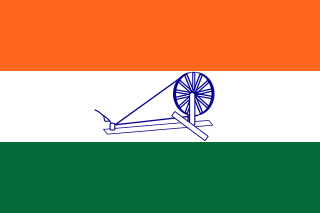
The Provisional Government of Free India or, more simply, Azad Hind, was an Indian Provisional government established in Japanese occupied Singapore during World War II. It was created in October 1943 and supported by – as well as largely dependent on – the Empire of Japan.

The Kumaon Regiment is the highest decorated regiment of the Indian Army. The regiment traces its origins to the 18th century and has fought in every major campaign of the British Indian Army and the Indian Army, including the two world wars.
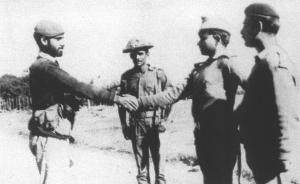
The Battle of Hilli or the Battle of Bogura was a major battle fought in the Bangladesh Liberation War. It is generally regarded as the most severe pitched battle that took place in East Pakistan, now Bangladesh. The battle of Hilli took place between 23 November 1971 and 11 December 1971, although the final surrender took place on 18 December 1971.

The Indian Order of Merit (IOM) was a military and civilian decoration of British India. It was established in 1837, although following the Partition of India in 1947 it was decided to discontinue the award and in 1954 a separate Indian honours system was developed, to act retrospectively to 1947. For a long period of time the IOM was the highest decoration that a native member of the British Indian Army could receive and initially it had three divisions. This was changed in 1911 when Indian servicemen became eligible for the Victoria Cross. A civilian division of the IOM also existed between 1902 and 1939, however, it was only conferred very rarely.

The Order of British India was an order of merit established in 1837 by the East India Company for "long, faithful and honourable service". The company's powers were removed after the Indian Mutiny, and the Order was incorporated into the British Honours System in 1859. The order became obsolete in 1947, after the partition of British India into the Dominion of India and the Dominion of Pakistan.
Savitri Bai Khanolkar was a designer, best known for designing the Param Vir Chakra, India's highest military decoration, awarded for displaying distinguished acts of valour during wartime. Khanolkar also designed several other major gallantry medals including the Ashok Chakra (AC), Maha Vir Chakra (MVC), Kirti Chakra (KC), Vir Chakra (VrC) and Shaurya Chakra (SC). She had also designed the General Service Medal 1947, which was used until 1965. Khanolkar was also a painter and an artist.

The Garhwal Rifles is an infantry regiment of the Indian Army. It was originally raised in 1887 as the 39th (Garhwal) Regiment of the Bengal Army. It then became part of the British Indian Army, and after the Independence of India, it was incorporated into the Indian Army.
The Indian honours system is the system of awards given to individuals for a variety of services to the Republic of India. The categories of awards are as follows:
The Sher-e-Hind was the highest military decoration awarded by the Imperial Japanese supported Azad Hind Government, established in Singapore in 1943. First instituted by Subhas Chandra Bose in Nazi Germany, this award was later also awarded to troops of the Indian National Army in South East Asia. The award could be conferred with swords for valour in combat, and without swords for non-combat awards. At least three awards were made, to Captain Baru Singh, Captain Kunwal Singh and one to Capt Ganeshi Lal.
The Sardar-e-Jung was the second highest military decoration by the awarded by the Azad Hind Government. First instituted by Subhas Chandra Bose in Germany, it was later also awarded to troops of the Indian National Army in South East Asia. The award could be conferred with swords for valour in combat, and without swords for non-combat awards. At least two awards were made, one to Colonel Shaukat Ali Malik for the capture of Moirang, and to Capt Shangara Singh Mann. Capt. Mann was also awarded the Vir-e-Hind medal. Colonel Pritam Singh was awarded Sardar-e-jung, he captured a hill named Pritam Hill in Myanmar, Burma & Palel Airport. Lt. Kunwar Balwant singh was also awarded Sardar ae jung while he was company commander for kaladan valley operation where he captured a British post named 'MODAK', now in Bangladesh.
The Vir-e-Hind was a military decoration awarded by the Azad Hind Government. The award was a second class star below the award of Sardar-e-Jung. First instituted by Subhas Chandra Bose in Germany, it was later also awarded to troops of the Indian National Army in South East Asia. The award could be conferred with swords for valour in combat, and without swords for non-combat awards. At least one award was made, to Capt Shangara Singh Mann. Capt. Mann was also awarded the Sardar-e-Jung medal.
The Shahid-e-Bharat was a military decoration awarded by the Azad Hind Government to honour the fallen. It was awarded in gold or in silver. First instituted by Subhas Chandra Bose in Germany, it was later also awarded to troops of the Indian National Army in South East Asia. The award could be conferred with swords for valour in combat, and without swords for non-combat awards.
The Tamgha-e-Bahaduro was a military decoration awarded by the Azad Hind Government. First instituted by Subhas Chandra Bose in Germany, it was later also awarded to troops of the Indian National Army in South East Asia. The award could be conferred with swords for valour in combat, and without swords for non-combat awards.
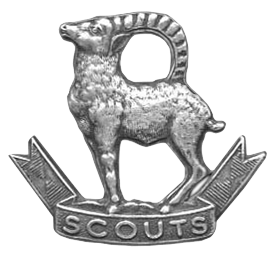
The Ladakh Scouts is an infantry regiment of the Indian Army, nicknamed the "Snow Warriors" or "Snow Tigers". The regiment specialises in mountain warfare, and its primary role is to guard India's borders in the high altitudes of the Union Territory of Ladakh.

Naib Subedar Chuni Lal AC, VrC, SM was an Indian Army soldier of 8th battalion. The Jammu and Kashmir Light Infantry. He was born in Bhaderwah, and basically from Gandhari Paddar and lived in Bhara village in Doda district of Jammu. Decorated with Vir Chakra and Sena Medal (Gallantry), JC-593527, Lal was martyred on 24 June 2007 in a militant flush-out operation in Kashmir’s Kupwara sector. These militants, all of whom were also shot dead, were trying to cross the Line of Control (LoC) and enter Indian territory. The success of this militant flush-out operation, which claimed his life, earned him the highest peacetime military decoration awarded for valor, courageous action or self-sacrifice away from the battlefield, the Ashok Chakra.
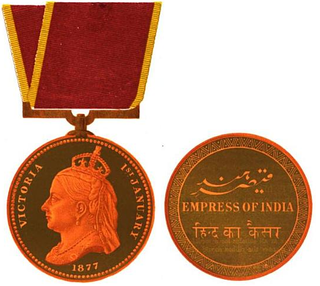
The Empress of India Medal, also referred to as KIH Medal, was a commemorative medal awarded to mark the occasion of the proclamation of Queen Victoria as Empress of India in 1877. It was the first wearable medal issued to mark a commemorative occasion within the British Empire. The medal was awarded in gold to Indian princes and senior officials and in silver to selected British and Indian military officers and civilians, as well as one soldier from each British and Indian regiment serving in India at the time of the proclamation celebrations of the 1877 Delhi Durbar.
Shangara Singh Mann was an officer of the Indian National Army during World War II. He served as a captain and company commander during some of the earliest fighting against the British Indian Army in Assam, for which he was awarded the Sardar-e-Jung, the second-highest decoration bestowed by Azad Hind for valour in combat, and the Vir-e-Hind medal. Subhas Chandra Bose himself gave Singh Mann his medals in Rangoon. He was captured by the British and held in a prison in Multan from January 1945 to February 1946. Soon after he was released and he returned to his family in the Punjab, his life was disrupted by the partition of India. In 1959, he settled in Vadodara, Gujarat, where he remained as of 2001. He died at the age of 113.
References
- ↑ Shaikh, Sajid (6 October 2001). "INA's soldier lives in oblivion in Vadodara". The Times of India . Archived from the original on 18 October 2012. Retrieved 7 July 2007.
